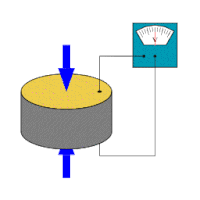
Photo from wikipedia
Constraining a piezoelectric material from freely expanding causes a reduction in capacitance. This reduction in capacitance has implications in energy harvesting, active vibration control, and ultrasonic sensing. This article investigates… Click to show full abstract
Constraining a piezoelectric material from freely expanding causes a reduction in capacitance. This reduction in capacitance has implications in energy harvesting, active vibration control, and ultrasonic sensing. This article investigates the reduction in capacitance when a thin piezoelectric disk is embedded in an isotropic host material. Both simplified (one-dimensional axisymmetric) and computational (finite element two-dimensional axisymmetric) analyses have been presented and used to calculate the expected reduction in capacitance of thin embedded piezoelectric disks for a number of ceramic-based piezoelectric materials. The analyses show that there is a non-linear relationship between the capacitance and the elastic modulus of the host material; with increasing host modulus, capacitance initially decreases rapidly but then asymptotically converges to the fully constrained case. A simplified equivalent spring axisymmetric model has been derived from the finite element model and has been used to explain some of the key geometric and material properties that effect the reduction in embedded capacitance. Preliminary experimental results show some agreement with the derived models; however, substantial further validation is required. Some implications of the derived results for energy harvesting are also discussed.
Journal Title: Journal of Intelligent Material Systems and Structures
Year Published: 2017
Link to full text (if available)
Share on Social Media: Sign Up to like & get
recommendations!